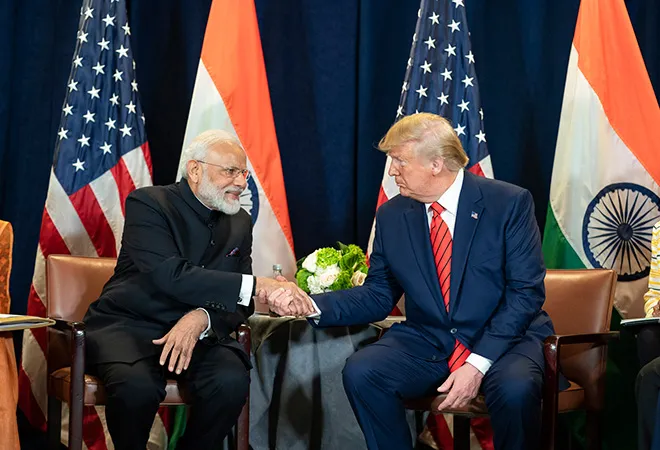
At the ‘Howdy, Modi!’ rally in Houston, the promising trajectory of US-India witnessed yet another historic episode. Amidst a thumping crowd of over 50,000 members of the Indian American community, Prime Minister Narendra Modi and President Donald Trump put on a political spectacle like no other -- animated by their political imperatives. An election-focused Trump hitched his political arithmetic on the Indian diaspora to the political heft of the popular Indian prime minister. Meanwhile, Modi amidst an economic slow-down back home, harnessed this moment to herald his global statesman credentials. Beyond the event’s relevance for political optics however, the centrality of US-India defence ties was writ large.
In-line with his administration’s “Buy American” plan -- of lifting the “self-imposed policy restrictions that limit potential opportunities for business” of arms exports, Trump hailed US arms sales to India to have peaked at USD 18 billion over the past decade. Further, the real-estate mogul turned Commander-in-Chief even slipped in a gloat: “We make the greatest defence mechanisms and equipment anywhere in the world, and India knows that well.” Trump also announced that come November, the United States and India will “demonstrate a dramatic progress of our defence relationship” by holding the “first-ever tri-service military exercise” called “Tiger Triumph”.
At a time when US-India trade tensions have riddled the bilateral dynamic, this announcement -- by an American president known to link defence matters to inconsistencies on the trade front with partner nations, signifies the insulation of US-India defence ties from bilateral turbulences.
Anticipated “early-harvest” trade deal of low-hanging fruits
According to reports, during this ongoing visit, Modi and Trump may ink an “early harvest” trade deal -- which could also see the reinstatement of Generalized System of Preference (GSP) benefits to India. Earlier this year, amidst mounting American impatience with the continually stalled trade talks between India and the US, the Trump administration had revoked India’s status under the GSP regime. Since then, trade tensions have gripped the bilateral dynamic with India even imposing duty on some US goods as a retaliatory response to the US’ Section 232 tariffs on steel and aluminium.
Some commentators expected a mega announcement on this reported “partial” trade deal at the ‘Howdy, Modi!’. However, neither Trump nor Modi addressed trade differences specifically in Houston. It is thus expected that any developments on this front must be set to occur on the side-lines of the United Nations General Assembly in New York.
Although any such deal would be a welcome thaw, it is largely set to be one of incremental gains. This would possibly be with regards to some low-hanging fruits such as, reducing Indian duty on imported high-end mobile phones (such as Apple iPhones) and American motorcycles (such as Harley Davidson motorcycles), and raising Indian energy imports from the US to further address the bilateral trade deficit. Whereas, major bones of contention – like the Indian insistence on price caps on “coronary stents and knee implants resulting in the lowering of prices by 85% and 65% respectively”, are likely to remain.
In this context of the expected continuation of US-India divergences on trade, the announcement of the much-anticipated tri-service exercise conveys the Trump administration’s security policy towards India to be informed by independent considerations -- beyond mere commercial potentialities for the US on India being one of the world’s largest arms importers. A testament of the same has been the Trump administration’s continuation of US policy on pursuing force interoperability between US and India.
Rising tempo of US-India force interoperability
With the absence of a treaty alliance between India and the US, “part of the problem is that Washington has no template for a close defence relationship outside of the obligations inherent in a formal alliance.” Thus, the broader US-India dynamic and specifically the on-ground component of force interoperability, requires an equally unique approach – often feasible only when considerable political will is expended by either partners.
With the US’ emphasis on a “free and open” Indo-Pacific – wherein the US and India are envisaged as “the two bookends of stability”, the American political will on enhancing US-India defence ties cannot be understated. On the Indian side, the Modi government has recalibrated the erstwhile Indian notion of ‘strategic autonomy’ to ‘strategic alignment’ – “as an objective that is attainable through strengthened partnerships instead of avoiding partnerships”.
An example of that convergence of political will between India and the US, was apparent in the final days of the Obama administration and the early years of the Modi government. In 2016, the US and India signed the Logistics Exchange Memorandum of Agreement (LEMOA). The same put in place “basic terms, conditions, and procedures for reciprocal provision of logistic support, supplies, and services between the armed forces of India and the United States.” Thereafter, the Trump administration has built on its predecessor administration’s focus on enhancing force interoperability with New Delhi. Meanwhile, the Modi government has reciprocated as before. For instance, one year into the Trump presidency, the US and India signed the second US-India defence interoperability pact — the Communications Compatibility and Security Agreement (COMCASA). The same facilitates “access to advanced defence systems and enable India to optimally utilize its existing US-origin platforms.”
Under a year since then, American and Indian officials are now reportedly working towards ironing out differences on the final US-India defence interoperability agreement — the Basic Exchange and Cooperation Agreement (BECA), for joint access to geospatial maps.
The notable tempo of these developments is spurring the gradual institutionalisation of US-India defence ties. That is, platform synchronisation via these formal agreements –– that mostly pertain to technicalities like geospatial mapping and communications, supplementing the operational synchronisation at play during US-India military exercises.
Prioritising force readiness for a rainy day in the Indo-Pacific
Just last week, the US and India conducted the 15th edition of the two-week long ‘Yudh Abhyas' — one of the longest running joint army endeavours between the US and India. The same encompassed the American and Indian armies to rehearse multiple scenarios “with a view to understand each other's organisational structure and battle procedures which would result in a higher degree of 'jointmanship' that would further facilitate interoperability between the armed forces of the two nations to meet any unforeseen contingency across the globe.” Interestingly, it stands as one of many events on operational synchronisation between India and the US. Notably, New Delhi already conducts “more joint military drills, tabletop exercises, and defence dialogues with the US than with any other country, which include more than 50 ‘cooperative events across all Services’ annually".
US-India defence ties thrive under two broad domains –– defence trade and force interoperability. Beyond the Trump administration’s commercial motivations behind the former, impetus to US arms exports to India is aimed at increased capacity-building –– towards India eventually assuming the role of a goods provider in the region. Whereas the latter, is posed as a confidence-building measure — aimed at India’s gradual acclimatization to the Indo-Pacific construct which purports the Indian Ocean and Western Pacific regions to have interconnected destinies.
This aim of ‘socialising’ India into the Indo-Pacific calculus is apparent even in the nomenclature adopted in US-India military exercises. Consider the exercise between Indian and American Air Forces held in late December 2018. Last conducted in 2009, the 12-day joint exercise was revived and hosted at two Indian air bases — Air Force Station Kalaikunda in Midnapore and Air Force Station Arjan Singh at Panagarh, both “located in the eastern Indian state of West Bengal, not too far from the Sino-Indian border where Indian and Chinese forces were locked in a confrontation in 2017.” Interestingly, this exercise was termed ‘Cope India 2019’.
Similarly, the raison d’être –– as to which country is being set for triumph, with the announced tri-service ‘Tiger Triumph’ exercise is clear. Hint: There are no tigers in Yellowstone National Park.
Thus, as US-India trade talks are expected to remain hijacked by long-standing divergences, the continued emphasis on US-India defence ties can be attributed to reasons beyond Trump’s commercial motivations on tapping India’s burgeoning arms market. Furthermore, the Trump administration’s impetus on formalising force interoperability pacts, with it now reaching the crescendo of the announced tri-service ‘Tiger Triumph’ exercise, signifies the insulation of US-India defence ties from bilateral turbulences.
The views expressed above belong to the author(s). ORF research and analyses now available on Telegram! Click here to access our curated content — blogs, longforms and interviews.




 PREV
PREV


